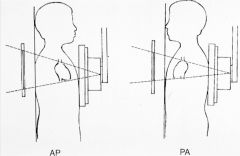![]()
![]()
![]()
Use LEFT and RIGHT arrow keys to navigate between flashcards;
Use UP and DOWN arrow keys to flip the card;
H to show hint;
A reads text to speech;
15 Cards in this Set
- Front
- Back
|
How do x-rays passing through the body create an image?
|
X-rays that pass through the body to the film render the film dark (black)
X-rays that are totally blocked do not reach the film and render the film light (white) Air = low atomic # = x-rays get through = film is dark Metal = high atomic # = x-rays blocked = film is light (white) |
|
|
5 Basic Radiographic Densities?
|
Air- black
Fat-light gray soft tissue/fluid-Medium Gray Mineral (bone)- white metal-bright white |
|
|
What are the 4 things you should look for on a film?
*** ON TEST |
Size (heart
Shape and contour Position Density |
|
|
Demonstrate the ability to optimally view images
|
you want it to be dark and have limited distractions
|
|
|
when reading a chest xray what are the things to look at?
|
MD PLOTS
M = Mediastinum D = Diaphragms P = Pleura L = Lungs O = Osseous structures T = Trachea S = Stomach/soft tissues |
|
|
what is the only view you see the edge of the right ventricle?
**** |
Lateral
|
|
|
what is the only chamber of the heart you can see in a lateral view
|
right ventricle
|
|
|
just read this
|

|
|
|
which view has LESS magnification...AP or PA?
why? |
Less magnification on a PA Chest radiograph because:
The heart is closer to the cassette X-ray source is 6 ft. from the cassette |
|

|

|
|
|
what is the cardiothoractic ratio?
|
if the transverse cardiac diameter measures more than half of the greatest internal diameter of the chest, it is considered enlarged
|
|
|
be able to recognize the borders of the heart
flip to see |

|
|
|
What is the magnification difference between an AP and a PA view?
|
AP are magnified 15-20%
|
|
|
What are the benefits of:
PA view AP view Lateral or decubitis view Inspiratory view Expiratory view |
PA view- less magnification
AP view- this is mobile lateral or decubitis- use to look for fluid in the chest or free air in the abdomen Inspiratory- ideal for any chest x ray, heart is raised, diaphragm is flattened and lowered Expiratory- best when looking for a pneumothorax |
|
|
It is abnormal to see vasculature in what portion of the lung?
|
If you divide the lung into interior, middle and lateral portions, you should not see any vessels in the lateral portion.
|

